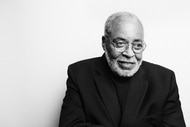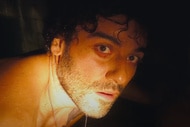Create a free profile to get unlimited access to exclusive videos, sweepstakes, and more!
SYFY turns 30: Remembering the first broadcast of the Sci-Fi Channel
On Sept. 24, 1992, a countdown clock ticked away the seconds until the Sci-Fi Channel made its debut.

In sci-fi movies, a countdown clock is rarely a good thing. However, 30 years ago, a countdown clock reached zero, marking the launch of something very, very good: The Sci-Fi Channel. Yes, the network now known as SYFY began broadcasting 30 years ago tomorrow. It was a momentous occasion, one that added exciting genre movies and shows to millions of TV screens. Back then, the Sci-Fi Channel looked a little different than it does today, and it was making its debut in a very, very different media landscape.
The Sci-Fi Channel was the brainchild of Mitchell Rubenstein and Laurie Silvers a husband and wife duo of entrepreneurs living in Boca Raton, Florida. In the early ‘90s, the pair attempted to make their idea a reality, but it wasn’t until USA Networks (at the time a joint venture between Paramount and MCA, a since-renamed part of NBCUniversal) acquired the rights that things really got going. They worked to secure rights for genre programs they could populate their new channel with, got sci-fi luminaries like Gene Roddenberry and author Isaac Asimov aboard as advisors, and promoted the channel so that sci-fi fans would be excited when it launched on Sept. 24, 1992.
The lead-up to the debut of the channel was marked with intriguing, somewhat ominous promos warning of “an invasion” that was “coming for you.” As the date drew closer, a countdown clock ticked down the seconds until the Sci-Fi Channel made its debut on a reported 10 million of the United State’s then-56 million cable-owning households. (In New York City, Star Trek’s Leonard Nimoy was the Master of Ceremonies at the launch party, which was held in the Hayden Planetarium.) The first official broadcast of the Sci-Fi Channel was a sad one, dedicating it to Roddenberry and Asimov, both of whom had died before the Sci-Fi Channel launched.
The dedication was followed by a nifty little faux news report from the year 2142. In the early days, cute little bumper segments like this were common on the network, and early promotional materials promised that “every second of air time between programs and commercials will be stocked with science fiction side lights and highlights,” including “NASA Moments,” “Sci-Fi News Capsules,” and “Clips of Classic Sci-Fi Animation,” to name a few. This opening segment, framed as a new service called Faster Than Light (FTL) Newsfeed, had a floating, Tron-like head explaining that the “Floating Star Wars Museum and Theme Park” had found “the only known complete print of the 165-year-old science-fiction masterpiece Star Wars,” and that they would be broadcasting it as a promotion.
This was a creative way to set up the Sci-Fi Channel’s first bit of programming: A prime-time broadcast of the original 1977 Star Wars. (Looking back 30 years later, the FTL Newsfeed framing device is especially funny, because the idea of there being only one surviving complete print of Star Wars seems inconceivable now that Disney owns Star Wars. Although, on the other hand, this was before the 1997 Special Edition, which means that Han shot first on the Sci-Fi Channel. Finding a way to watch the actual, original Star Wars in this day is indeed tricky.)
When the Sci-Fi Channel launched, it had the rights to roughly 300 movies in addition to Star Wars, including some Universal Classic Monster movies like Dracula and Frankenstein and four Star Trek movies. On the TV side, there were shows like Voyagers!, Buck Rogers, Incredible Hulk, Rod Sterling’s Night Gallery, and (the original) Battlestar Galactica. Shows from other networks that had been underseen or canceled after only one season got a second chance on the Sci-Fi channel, which aired what limited episodes of various forgotten programs they had in special programming blocks. Older shows aired at night, newer ones in primetime, with movies playing on the weekends, for the most part.
It may be hard to believe now, but 30 years ago it was much more difficult to watch genre content, and many fans might’ve missed what the Sci-Fi Channel had to offer the first time they went around. The Sci-Fi Channel provided an important niche back then, especially because geeks didn’t yet control pop culture. Today, there are new Star Wars series premiering to great fanfare, almost all the top movies at the box office are based on superhero comic books, and Dungeons & Dragons is cool. That wasn’t the case in 1992, when the idea of a whole channel devoted to Sci-Fi was a curiosity — a good business idea, but still an oddity.
The Sci-Fi Channel would evolve as the years continued. The name changed — a couple of times, actually — and the current SYFY is more polished and professional than the network’s quirky origins. Today, SYFY broadcasts tons of sci-fi, horror, and other genre movies, and there are great original series like Resident Alien, Chucky, and SurrealEstate.
But, it all began with a countdown clock, a dedication to two late greats, a fake newsreel from the future, and a primetime broadcast of Star Wars.




























